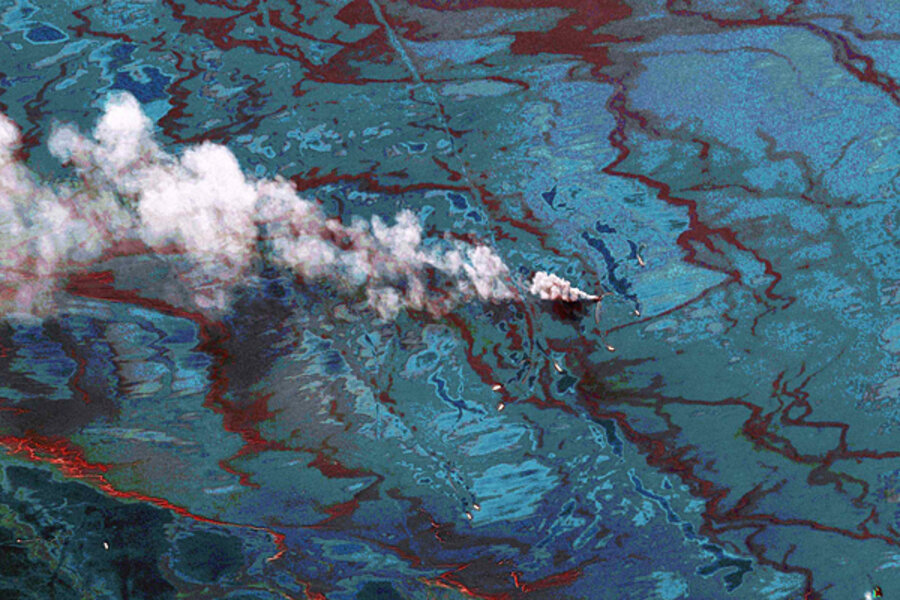Human rights: Use satellite "spy" camera for proof and prevention
Loading...
| San Francisco
As Sri Lankan infantry cornered the last of the Tamil Tigers in May 2009, another plot was unfolding 9,000 miles away. Lars Bromley was pulling 15-hour days as he watched the conflict unfold from a different perspective: that of satellites peering down from 450 miles above.
In a Washington, D.C., lab he scrolled through digital satellite photos measuring 16 feet by 16 feet as part of the Science and Human Rights Program at the American Association for the Advancement of Science (AAAS). Mr. Bromley, a geographer, hoped to determine whether the Sri Lankan Army was attacking a civilian safety zone.
Each pixel on the photos represented 20 inches, so the photos weren't sufficiently fine-grain to reveal corpses. But Bromley and his co-workers spied other damage: buildings shattered by artillery shells, and mortar craters pocking the sand in places where refugees had previously gathered. Elsewhere, the rectangular grids of Tamil Tiger cemeteries grew from one day's photo to the next, revealing dozens of new graves.
The Sri Lankan government denied targeting civilian areas. The fact that information still got out so quickly from a region off-limits to outsiders is testament to a growing truth: From Google Earth to GPS to spycraft, satellites make the world more accessible than ever.
Private satellites have carried telecommunications for decades. But since 1999, nearly a dozen commercial imaging satellites with photographic resolutions between 6 feet and 20 inches have launched into orbit. Companies using the satellites sell imagery to governments; private companies in agriculture, urban planning, and telecommunications; and – most recently – to environmental and human rights organizations.
Worldview 1, a satellite built by the Colorado-based company Digital Globe, supplied much of the imagery that Bromley used in Sri Lanka. Worldview 1 orbits Earth at 17,000 m.p.h. and photographs a 10-mile by 60-mile strip of land at 20-inch resolution in 25 seconds, capturing 150,000 square miles every day.
AAAS's first satellite project in 2005 documented home demolitions by the regime of the dictator Robert Mugabe in Zimbabwe. A project in 2007 revealed the burning of hundreds of villages in Darfur. Others have investigated abuses in Burma (Myanmar), Gaza, North Korea, Ethiopia, and the Democratic Republic of Congo. And as the Arab Spring unfolds with spurts of violence, people at human rights organizations are reviewing imagery from Libya, Egypt, and other locations.
"It's really been exceptionally valuable," says Scott Edwards, director of the Science for Human Rights Program at Amnesty International.
People are still learning new ways to use the data. As Bromley's team monitored Sri Lanka in 2009, a team member who studied meteor craters on Mars noticed sprays of soil kicked up from mortar craters. The orientation of those sprays allowed him to extrapolate the trajectory of incoming shells – and ultimately, trace them back to Sri Lankan Army positions.
Far more profound, though, is the growing realization that people on the ground may well know someone is watching. Last July, as analysts examined photos of the city of Osh, Kyrgyzstan, where 1,600 homes were burned during ethnic violence, they saw something that shocked them: "SOS" was painted on roads and fields in more than 100 places in letters up to 60 feet tall.
Such events highlight the limits of satellites. Their orbits take them over a given location at fixed times, permitting a snapshot of the same spot only every couple of days – assuming no clouds. In effect, people must make do with photographing crime scenes rather than watching or intervening in events as they unfold.
Patrick Meier, a visiting scholar at Stanford University, in California, who cofounded the global network Crisis Mappers, would like to do more: "You're not just documenting human rights abuses so you can bring someone to justice in The Hague three years later." The question, he says, is: "Can you provide tactical data for people to act on and get out of harm's way?"
Human rights isn't the only area in which satellites have unforeseen impact. Satellites launched to study basic science questions have also located natural resources that could help poor countries.
Farouk El-Baz, director of the Center for Remote Sensing at Boston University, has used orbiting radar to find lakes hidden beneath the sands of North Africa. "The radar waves penetrate sand as though it does not exist," explains Dr. Baz. "It gives us an image of the solid rock beneath the sand, and that shows us the courses of former rivers."
He first found a buried lake beneath southern Egypt in the 1980s; since then it has been tapped by 1,000 wells, allowing wheat cultivation in a formerly dry area. In 2007 he found a similar lake beneath Darfur. So far, only 20 wells have been drilled there – ironically, due to low-tech problems. "When you go into a place where there is no road, no town, no village, no place to buy gasoline or food, you have to do all of these things yourself," he says. "So it's not a small thing."
Editor's note: This article is No. 2 of the FutureFocus package "5 Innovations Changing the World".
No. 1 - A tinier chip, needing one-thousandth the power of today's conductors, isn't impossible.
No. 3 - Villages leapfrog the grid with biometrics and mobile money
No. 4 - E-fabric spools bring bullet-proof watches, paper-thin batteries
No. 5 - Where solar power can't fly, artificial photosynthesis might





